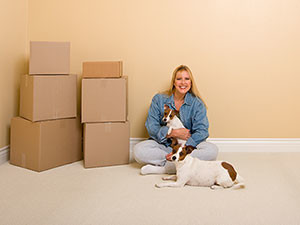Moving with your dog
We thought this article was especially important this time of year. One of the TOP reasons we are requested to take a dog into the program via owner surrender is: “I’m moving out of state and I can’t take my dog.” – There are no states in these United States of America that prohibits dog ownership!
By Juliana Weiss-Roessler
When I look back on my family’s move from Los Angeles to Austin, I still don’t know how we managed to make it on the plane with our one-year-old son and two dogs – along with our luggage, playpen, dog crates, and car seat.
But it wasn’t just the plane ride; every stage of the move was made more challenging with three creatures who weren’t interested in sitting still while we checked off our to-do list.
Whether your move is long-distance or just down the block, there’s a lot to accomplish. Here are a few things I learned from my experience – and a few I learned about afterwards – that will help you and your pups with the transition.
Leaving your old home If you’re a renter, then your only concerns on moving out are cleaning up and minor repairs in order to get your deposit back. However, if you’re a homeowner looking to sell, dogs can complicate the process a bit.
Keeping your home clean for potential buyers and getting out of the way for viewings can be a challenge if you have dogs. But it’s a necessary part of the process if you want your home to sell.
- Amp up the walks There’s a lot going on, but it’s important not to neglect your dogs’ needs now. Exercise keeps their energy down, which means they’ll be less likely to engage in messy, destructive behaviors at home, and they’ll be more likely to cooperate if you have to leave the home fast for a showing or leave them in their crates.
- Have a game plan Have everything you need to get out of the house in one dedicated location, and know where you’ll head if someone calls for a last minute showing. Being prepared will make it less stressful for everyone.
- Schedule showings during your usual walk time It won’t always be possible, but let your realtor know that those are the best times for your family.
- Restrict your dog’s access If you’re like my family, your dog is welcome in every area of your home, but during this time, consider making certain areas off-limits to keep them cleaner. This can be done simply by shutting doors to certain rooms, or using a doggy gate.
- Never, ever leave your dogs loose during a showing Even the friendliest dog can frighten someone who isn’t comfortable with dogs, and you always run the risk of a visitor leaving a door or gate open and allowing your dog to escape. Instead, put your dogs in their crates if you can’t get them out of the house with you. If you’re looking to rent a new place, the first consideration, of course, is whether they accept dogs at all, so do your research first with an online tool like Rent.com’s pet-friendly search. Remember: a lot of places will require proof of vaccination before they’ll let your dog move in, so be sure you’re up to date and have the documentation.
- If you’re buying a house, shopping for your new home is one of the most enjoyable parts of the moving process. But whether renting or buying, it’s important to take your dog into consideration while going through it.
- Finding your new home
- Find nearby dog-friendly locations Do you currently love taking your pup to the dog park or for a walk down to your local café, where the baristas leave him a bowl of water and a treat? Make sure you can maintain similar routines in your new location.
- Consider your dog’s new living quarters It’s likely you’ve ensured the new home has enough bedrooms for the human occupants, but what about your dog? Where will his dog bed live? His food and water?
- Look into backyard safety When moving with my pups, one of the things I was most excited about was giving them their first backyard, so that was on my list of must-haves: a safe, fenced-in area where they could roam. But you should also look at how visible your dogs are when outside. If they can be seen from a major roadway while behind your fence, it can put them at higher risk of being stolen.
- Check out other neighborhood animals When you’re seriously considering a home, take a walk with your dog around the block. Note the barking dogs in backyards, roaming cats, or other creatures, and consider how they may affect your daily routine. You’ve found your new dream home and are ready to leave the old one. Now it’s time for the dreaded process of putting everything you own in boxes. Here’s how to help your dog through it.
- Packing and unpacking
- Maintain your calm Recognize this may be anxiety-inducing for your dog, but it will be especially so if you are feeling stressed about it. You can also help reduce your dog’s fear about the major changes going on by maintaining his routine as much as possible.
- Pack your dog’s room last Whatever room is your pup’s favorite, save it for the end. That way, she’ll spend less time with the upheaval there stressing her out.
- Get your dogs out for moving day There are a lot of people coming and going during the actual moving out and in, and that means many opportunities for a stressed dog to escape. On my moving day, I took both dogs and the baby to a nearby dog-friendly restaurant to hang out until it was all over. Other ideas are to ask a friend or family member to have them over for the day or find out if your vet offers boarding. Not an option? When in doubt, a crate can help ensure they are safe. For my family, it was a no-brainer. There was no way that all five of us were up for a cross-country trip in a moving truck. We hired a moving company to take our stuff, and then we all boarded a plane. But for some families, driving with all your household items and household members can be a fun adventure.
- A few things to consider for your pup when deciding between methods of transportation:
- Traveling to your new location If your move is long distance, you’ll need to decide how to move your items as well as your family to your new location.
- Your car ride will take longer with a dog joining you Do you normally like to drive as many hours as possible before you stop? That’s not best for your dog, who should get out to stretch his legs and take a bathroom break every four to six hours. Naturally, this will add to your travel time. Also, make sure you plan where you will stay the night. It may not always be easy to arrange pet-friendly accommodations unless you do so in advance.
- Larger dogs cannot travel in-cabin If your dog is small enough to fit underneath a plane seat, she can likely travel with you on the plane, but larger dogs must go with the cargo. Hundreds of thousands of dogs travel safely in cargo, but there is a risk posed by greater temperature variations.
- Older dogs may not be up for a long trip Whether it is days on the road or hours unsupervised in cargo, senior dogs can be at greater risk of suffering health issues. Talk to your veterinarian about what travel method is safest. In some cases, you may have to make the tough choice of re-homing your dog with a friend or family member rather than putting him through the ordeal.
- Get a baggage cart for your plane ride I’ll be honest: I’m a penny pincher. Who needs a cart when suitcases have wheels? The answer: you do! You’ll appreciate having more hands available to meet your dog’s needs as you travel through the airport.
- Settling in Now is the time to set up or re-establish good habits! Focus on rules, boundaries, and limitations.
- Establish your new routine quickly It’s likely some things will change in the new home, but try to stay as close as possible to your previous routine. If you’ve switched time zones, jump right into the new schedule like it didn’t even happen. Still go for that 9 a.m. walk in your new location – even if it may feel like 11 a.m. to your dog.
- Update your dog tags You want your new contact information on your dog stat. Being in a new place can increase the chances that your dog bolts and gets lost.
- Find a veterinarian Ask for recommendations from neighbors and co-workers, and get your dog in for a check-up. Getting your dog in before an emergency situation arises can help him get to know the new vet in a relaxed way. Especially if you spend a lot of time outdoors, find out if there are any region-specific vaccines that your dog may now need.
- Don’t wash those dog blankets When moving, your gut instinct may be to get everything fresh and new – but stop at your dog’s items. Keep them smelling just like your pup. That familiar scent can help him feel more at home in a new location.
- Read more: http://www.cesarsway.com/dog-travel/Moving-with-your-dog#ixzz3bLYGkcDO

